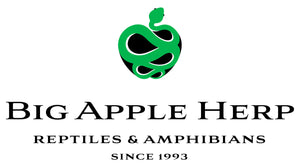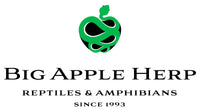Care Sheet For Bearded Dragons
Bearded Dragons are the number 1 selling reptile in the pet industry for a number of reasons: most people consider them absolutely adorable, they have true individual personalities and they are very tame. In fact, some say that Bearded Dragons enjoy being handled and like to be pet. Caring for Bearded Dragons is relatively simple if you follow our general food and enclosure guidelines.
Additionally, they are easy to breed and if properly cared for can live from eight to twelve years. Captive Bred Bearded Dragons (as opposed to wild caught) tend to be docile and gentle natured. At Big Apple Pet Supply, we carry only Captive Bred Bearded Dragons, and we maintain a strict quality control. We'll be happy to set you up with the correct cage, heating, lighting and accessories for your new pet.
Housing
One or two baby or juvenile Bearded Dragons can be set up in an enclosure as small as a 40 gallon (36" x 18" x 13"H). A larger minimum enclosure of 70 gallons (36" x 18" x 25"H) to the recommended 90 gallons (48" x 18" x 25"H) makes an excellent size for adults. A secured screen top is required to prevent your dragons from escaping the enclosure.
You may house several similar size female Bearded Dragons together but males are territorial and typically will fight. One male and several females can generally be housed together but we recommend this for more seasoned reptile enthusiasts as there are multiple issues that can arise causing stress, shortened lifespan, etc. Remember that even multiple females will compete for food so make sure any smaller Dragons are receiving their share of the food, heat, etc. You might consider separating any vastly smaller or larger animals.
Substrate
Sand is usually the best choice substrate for subadults and adult Bearded Dragons. You can use Zoo Med Repti-Sand or Zoo Med Vita-Sand but do not use industrial sand because it contains dust that that can be harmful. If you decide to use play sand use only extremely fine sand. Fine size play sand grain is hard to find which is why we recommend that you stick with the Repti-Sand or Vita-Sand products.
Baby Dragons are best kept on paper towels or similar product until they are about 10 inches long. As active feeders they usually ingest some of the substrate while gobbling up crickets or mealworms and while adults can usually digest some fine sand along with their food, babies cannot handle this as well or at all. We have heard of baby Dragons becoming impacted with sand and not being able to pass it so please follow this advice.
Heating
As with all reptiles, Bearded Dragons need a thermal gradient consisting of a Basking Spot (100° to 110° F) and a cool side (80° F). The best way to heat your Dragon enclosure is with a combination of a heat mat and ceramic heat emitter. We recommend the Intellitemp Heat Mat and Big Apple Black Heat Infrared Ceramic Heat Emitter to accomplish the heating of your Dragon's cage. The heat mat and ceramic heat emitter should be located on one side while the other side should not have any heat source. We recommend controlling the ceramic emitter with a thermostat, such as the BAH-500 or BAH-1000DC, and monitoring the temperatures with a thermometer to keep track of your warm and cool sides.
Lighting
Bearded Dragons must have a UV bulb to keep them healthy. We highly recommend a SunForce UV Mercury Vapor Bulb. Successful UV can also be produced with a Zoo Med Reptisun 10.0 bulb, but your dragon should be within 15 inches of the 10.0 bulb. Don’t forget you must change your UV bulbs every 6 months in order to maintain proper UVA/UVB.
Shelter
Bearded Dragons MUST have hiding places in their enclosure as it is essential to their well being. The shelter can be anything from a Big Apple Basic Reptile Hide Box to a decorative reptile shelter to a homemade cave. It is always a good idea to have one shelter on the warm side and one on the cool side. If you choose to make a hiding place yourself, please make sure that it is sturdy enough that there is no potential for collapsing and crushing your Dragon.
Shedding
Like all reptiles and amphibians, Dragons shed their entire skin all at once. Babies shed more often than adults because they outgrow their skin faster. Dragons can normally pull their shed off easily but sometimes they have issues if they do not have the proper humidity while shedding. You need to check your Dragon after it has shed to make sure it was able to peel all the skin off.
Providing a moist shelter will enable your Dragon to have a high humidity location when it is shedding. Use moistened Big Apple Imported Premium Grade Sphagnum Moss or Zoo Med Forest Floor Cypress Bedding. If your Dragon has retained skin after shedding you can place it in a small plastic container lined with warm, wet paper towels. With the top of the container on, let the Dragon sit for approximately 30 minutes. The high humidity in the container should loosen the skin enough to allow you to remove it easily with a pair of tweezers. If the skin has not loosened enough reheat the paper towels with warm water and provide another 30 minute session. NEVER use hot water as this can burn your Dragon's sensitive skin.
Water
It is true that Bearded Dragon’s typical environment is dry but they do require some humidity and water. Water should be made available three to four times a week by way of a bath in a water container. However, make sure your reptile can easily get in and out of the container. Bearded Dragons typically enjoy bath time and some will drink during their bath periods. We also recommend you mist down the vegetables you provide to your Dragon as this is an excellent way for them to get their water needs. It is a good idea for Baby Bearded Dragons to be misted occasionally and for the entire cage to be misted several times a week. This is especially true if your Dragon is getting ready to shed it’s skin. In addition, if you mist your Bearded Dragon directly they will often intake water that drips into their mouth.
Food
Bearded Dragons are hardy eaters and will typically devour a large number of crickets, mealworms, giant mealworms, superworms, wax worms and even small pinkie mice. However, wax worms and pinkie mice should only be offered occasionally due to their high fat content. When Bearded Dragons are babies they need to be fed insects twice a day and as adults, daily. We recommend feeding only as many crickets or mealworms as your dragon can eat in 10 to 15 minutes. It is important to select the proper prey size. The general rule for selecting the proper size of crickets is the cricket should be no longer than the distance between your Dragon's eyes. For baby dragons this usually means 3/8" crickets, for juvenile dragons 1/2" crickets, and adult dragons can handle full size crickets. NEVER leave any uneaten crickets in the cage with your dragon as they can actually cause serious damage and/or kill your reptile.
Dragons also require a large quantity of vegetables. As they grow from babies to adulthood the quantity of insects should be reduced while the quantity of vegetables should be increased. Vegetables can consist of leafy green lettuces, cucumbers, squashes, dandelion, green beans, carrots, sweet potato and any other healthy vegetable that you might put into a salad. Make sure to chop the vegetables into small pieces or grate them. Dragons will not be able to chew large pieces and it’s also not easy for them to digest. Fruits like papaya, grapes, berries and mangoes can also be offered but should make up a small percentage of the total diet.
Vitamins
It is important to feed high quality food to your prey items, called "gut loading". The food that is in the prey item's belly is the food that your reptile will be eating. In addition to this you need to coat your crickets and mealworms with vitamin and calcium powders before feeding them to your reptile. We recommend Herptivite Vitamins, Rep-Cal Calcium and Zoo Med Repti Calcium.
Cage Maintenance
Bearded Dragons require minimal maintenance so if you use a sand substrate you can do a quick cleaning of feces by using one of our scoopers. You can perform this 2 to 3 times a week or as needed to clean waste. The sand substrate should be completely thrown out and the entire cage (including all accessories) should be washed with Quat TB Pet Area Cleaner, Deodorizer & Stain Remover or a mild detergent at least once every four to five months. If using paper towels, change all paper towels at least once a week.
Hibernation
Hibernation for Bearded Dragons in the wild is natural, but is not necessary for pet Dragons. We believe you should heat your Dragons throughout the winter so they continue to eat, drink and be active. A general reduction in feeding behavior is normal during winter months due to temperature fluctuations in your house. As long as they keep fairly consistent weight it is generally not an issue and normal feeding typically resume in the spring.

